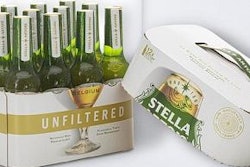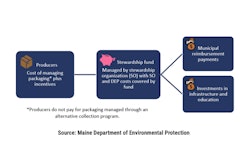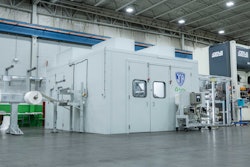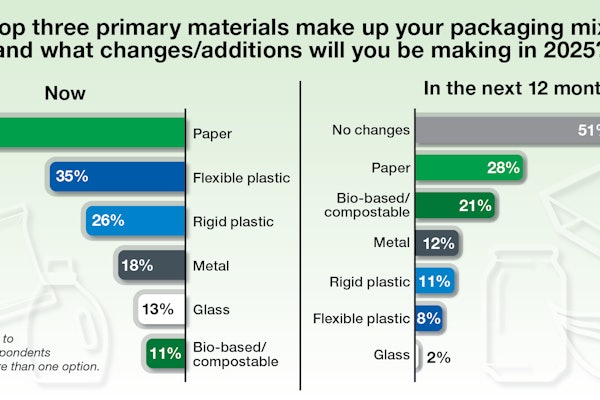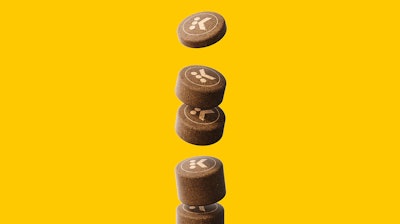
Keurig Dr Pepper (KDP) this week introduced a new single-serve coffee packaging concept, what calls its K-Rounds plastic-free pods. K-Rounds pods contain roasted coffee beans that are ground, pressed, and wrapped in a proprietary, protective plant-based coating (primary packaging) preserving the coffee’s flavor and aroma while eliminating the need for plastic or aluminum packaging. A corresponding brewing device called the Keurig Alta brewer is required to brew these specialty K-Rounds.
It's notable that the plant-based coating doesn’t dissolve into the liquid coffee—it stays intact during the brewing process. So after the K-Rounds are brewed, consumers must dispose of the remaining pod shell, composed of a food-safe, plant-based material that the company says will be certified as backyard compostable (certification pending).
KDP is acutely aware that coffee, perhaps uniquely among food and beverages, is sacred to consumers. It’s aroma and flavor are ritualized such that coffee requires significant barrier layers in packaging to lock in flavor, aroma, and freshness for any stint on a shelf.
So how much of a barrier will this new primary packaging material provide, and how much shelf life can we expect from each individual pod? Will secondary packaging require more barrier to accommodate the compostable material as primary packaging? Packaging World caught up with Phil Drapeau, SVP, Future Coffee Systems, KDP to learn more. The bottom line? It’s still a work in progress, but more details will be coming soon as the project moves into beta phases.
Barrier considerations
Regarding the primary and secondary packaging barrier specifics, “we are working through all of that. I can't give you an official final shelf-life today,” Drapeau says. “Part of us wanting to announce the K-Rounds [before such specifics are defined] is to start the dialogue with our retail partners and consumers and other stakeholders, so we can work through ‘what is a final shelf-life going to look like?’”
He indicates that the compostable plant-based coating indeed brings some aroma and flavor protection properties to the table. However, it is likely that the coating's barrier properties are insufficient—on their own, at least—to provide the extended shelf-life that retailers and consumers would prefer. That means that secondary packaging will have to carry some of the barrier load.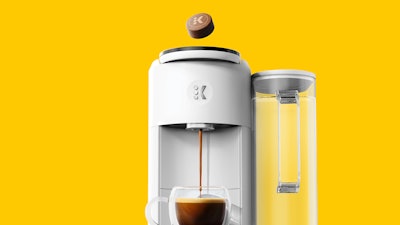 A corresponding brewing device, called the Keurig Alta brewer, is required to brew these specialty K-Rounds.
A corresponding brewing device, called the Keurig Alta brewer, is required to brew these specialty K-Rounds.
“The immediate packaging element for the coffee, that plant-based coating, it does have flavor and aroma protection,” Drapeau confirms. “The secondary packaging will also have some barrier protection within it. We’re working through the dynamics of the secondary packaging materials, exactly how much barrier protection that provides, and then how we package that up in terms of the product counts; the numbers of the pods per secondary pack. Those will be the numbers and the balances that will need to come together. How we match the secondary packaging to the primary packaging, and then pull that through from a final solution standpoint is what comes next, and we'll be able to share a lot more with you as we get into beta testing and refine the approach.”
Drapeau concedes that there are a lot of different options in front of the company at the moment in this work in progress, so he and his team are systematically working through them.
“We ask ourselves, ‘what are the things that actually, really work from a true barrier protection standpoint?’ And then we ask, ‘what meets our broader sustainability goals in terms of recyclability?’”
Secondary packaging to be recyclable, include additional barrier properties
Drapeau was very clear that KDP “certainly doesn’t want to go down a secondary packaging path that is not easily recyclable for consumers. And it has to be something that the municipalities want to recycle, too.” Beyond that, he’s also looking into the broader secondary packaging protections that any product—coffee, durable goods, or otherwise—needs for manufacturing, shipping, and the supply chain.
In a traditional coffee pod or K-Cup, barrier exists exclusively on the primary packaging. In this K-Rounds project, some of that barrier of is moving to the secondary package. The primary and secondary packaging will each have barrier duties, and the secondary packaging still must be easily recyclable. How that’s achieved, and whether the new K-Rounds system is in fact more sustainable than the legacy PP pods, is for an eventual Life Cycle Assessment (LCA) to decide.
“A full LCA is going to have to look at everything, from the full manufacturing process, even the start of life in terms of the coffee itself, its grinding, etc.,” he says. “We’re a little ways off from LCA. It's clearly on our radar screen, and we know how important that's going to be to take a holistic look. The focus started with end of life [of the packaging], to meet consumers’ needs, and then working our way back from there.”
Details on the sealant layer
As part of the intellectual property portfolio that KDP owns via the larger brewer and coffee round system project, KDP acquired a perpetual license to know-how and technology invented by Delica Switzerland for its CoffeeB system in Europe, including the proprietary plant-based coating and application processes. KDP’s partnership with Delica grants Keurig exclusive rights to use and build upon these technologies for consumers across the U.S., Canada, and Mexico.
“There are four components of the plant-based primary packaging coating, and they all meet the FDA standards for food safety,” Drapeau says. “The primary component in this sealant is alginate, which is typically derived from seaweed. [This project was] accelerated thanks to our partnership with Delica.”
Backyard composability certifications expected
“We fully expect it to be certified compostable, and the certification that we're going to be working through is TUV. We have a lot of respect for the approach that they take and what they do,” Drapeau says. “We fully expect the certification, it's just a matter of the final pods going through that testing. But everything that we know, from what coffee has done in our preliminary testing and onward, this is going to be [certified by TUV as] completely compostable.”
As with any compostable product, the remain sealant could be disposed of in the trash, too, where it would compost naturally.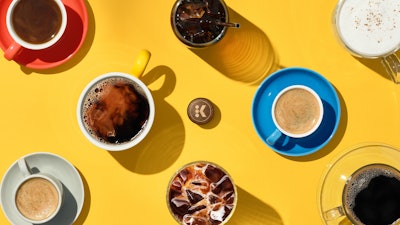 There’s a wide variety of consumer use preferences, from four-counts to counts in the hundreds, that must travel different supply chain channels. Beta testing the K-Rounds’ packaging with retailers, both brick and mortar and online, will be varied and complex.
There’s a wide variety of consumer use preferences, from four-counts to counts in the hundreds, that must travel different supply chain channels. Beta testing the K-Rounds’ packaging with retailers, both brick and mortar and online, will be varied and complex.
Inks for brew-style coding
As accompany images indicate, each K-Round is printed with a gold-colored “brew-style code” so consumers can easily identify among different varieties, like espresso (single or double) or dark vs. light roast coffee. This final approach here is also still in the works.
“We're still looking at a couple of different technologies to get the brew-style code etched on to the pods themselves. There are technologies that do actual etching, and then there certainly is food-safe inks that can be printed on the K-Rounds,” Drapeau says. “We're looking at a couple of different technologies, but we have to match that with the brewer [Keurig Alto brewing device] itself, because the brewer has to be able to read that brew-style code. That's important, which is why we're kind of experimenting with a few different options right now, while we're still in kind of this, you know, development stage and tightening these things down.
Beta testing is next
Keurig is an omnichannel brand that’s in 45 million homes across the U.S. and Canada. That means there’s a wide variety of consumer use preferences, from four-counts to counts in the hundreds, that must travel different supply chain channels. Beta testing the K-Rounds’ packaging with retailers, both brick and mortar and online, will be varied and complex.
“But that's also why we're so excited to get into our beta testing,” Drupeau says. “[Pack counts and sizes] are the things that the beta testing is really going to help us understand as we open up the variety of beverages, from essentially drip coffee in multiple sizes to, now, single-shot espresso, double-shot espresso, drip coffee, cold coffee that truly comes out cold like at a coffee shop. Understanding how consumers behave and what they drink and the varieties they choose, and then how that manifests in terms of usage patterns over 30, 60, 90 days, that all becomes really, really important to us. And that's why the beta testing is going to be so critical as we make the final decisions around pack counts and sizes and barrier protections and inks, and all those things.” PW


